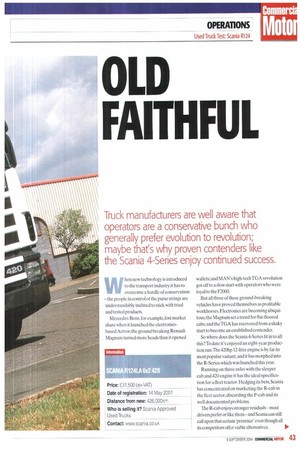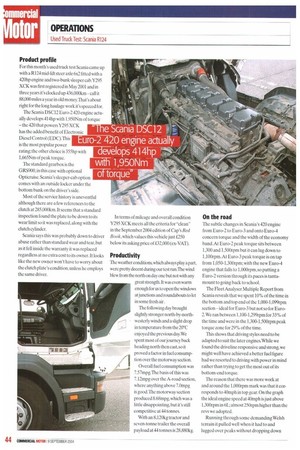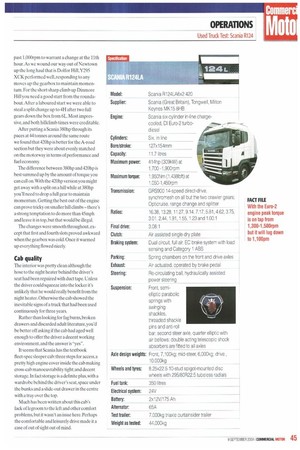OLD FAITHFUL
Page 43

Page 44

Page 45

If you've noticed an error in this article please click here to report it so we can fix it.
Truck manufacturers are well aware that operators are a conservative bunch who generally prefer evolution to revolution; maybe that's why proven contenders like the Scania 4-Series enjoy continued success.
lim new technology is introduced iria, to the transport industry it has to IN Mr overcome a hurdle of conservatism — the people in control of the purse strings are understandably inclined to stick with tried and tested products.
Mercedes-Benz, for example, lost market share when it launched the electronicsbased Actros; the ground breaking Renault Magnum turned more heads than it opened wallets: and MAN's high-tech TGA revolution got off to a slow start with operators who were loyal to the F2000.
But all three of these ground-breaking vehicles have proved themselves as profitable workhorses.Electronics are becoming ubiquitous;the Magnum set a trend for flat-floored cabs: and theTGA has recovered from a shaky start to become an established contender.
So where does the Scania 4-Series lit in to all this? To date it's enjoyed an eight-year production run.The 420hp 12-litre engine is by far its most popular variant, and it has morphed into the R-Series which was launched this year.
Running on three axles with the sleeper cab and 420 engine it has the ideal specification for a fleet tractor. Hedging its bets, Scania has concentrated on marketing the R-cab in the fleet sector, discarding the P-cab and its well documented problems.
The R-cab enjoys stronger residuals —most drivers prefer or like them—and Scania can still call upon that certain 'presence' even though all its competitors offer viable alternatives.
Product profile
For this month's used truck test Scania came up with a R124 mid-lift steer axle 6x2 fitted with a 420hp engine and two-bunk sleeper cab. Y295 XCK was first registered in May 2001 and in three years it's clocked up 436,0001un— call it 88,000 miles a year in old money.That's about right for the long haulage work it's specced for.
The Scania DSC12 Euro-2 420 engine actually develops 414hp with 1,950Nm of torque — the 420 that powers Y295 XCK has the added benefit of Electronic Diesel Control (EDC).This is the most popular power rating; the other choice is 355hp with 1,665Nm of peak torque.
The standard gearbox is the GRS900, in this case with optional Opticruise. Scania's sleeper-cab option comes with an outside locker under the bottom bunk on the driver's side.
Most of the service history is uneventful although there are a few references to the clutch at 285.000km. It seems that a standard inspection found the plate to be down to its wear limit so it was replaced, along with the clutch cylinder.
Scania says this was probably down to driver abuse rather than standard wear and tear, but as it fell inside the warranty it was replaced regardless at no extra cost to its owner. It looks like the new owner won't have to worry about the clutch plate's condition, unless he employs the same driver. In terms of mileage and overall condition Y295 XCK meets all the criteria for "clean" in the September 2004 edition of Cap's Red Book, which values this vehicle just £250 below its asking price of £32,000 (ex-VAT).
Productivity
'Ihe weather conditions which always play a part, were pretty decent during our test run.The wind blew from the north on day one but not with any great strength. It was even warm enough for us to open the windows at junctions and roundabouts to let in some fresh air .
The following day brought slightly stronger north-by-northwesterly winds and a slight drop in temperature from the 20°C enjoyed the previous day. We spent most of our journey back heading north then east, so it proved a factor in fuel consumption over the motorway section.
Overall fuel consumption was 7.57mpg.The basis of this was 7.12mpg over the A-road section, where anything above 7.0mpg is good.The motorway section produced 8.68mpg, which was a little disappointing, but it's still competitive at 44 tonnes.
With an 8,120kg tractor and seven-tonne trailer the overall payload at 44 tonnes is 28,880kg.
On the road
The subtle changes in Scania's 420 engine from Euro-2 to Euro-3 and onto Euro-4 concern torque and the width of the economy band. At Euro-2 peak torque sits between 1,300 and 1,500rnm but it can lug down to 1,100rpm. At Euro-3 peak torque is on tap from 1,050-1,300rpm; with the new Euro-4 engine that falls to 1.000rpm, so putting a Euro-2 version through its paces is tantamount to going back to school.
The Fleet Analyser Multiple Report from Scania reveals that we spent 10% of the time in the bottom and top end of the 1,000-1,099rpm section ideal for Euro-3 but not so for Euro2.We ran between 1,100-1,299rpm for 33% of the time and were in the 1,300-1500rnm peak torque zone for 29% of the time.
This shows that driving styles need to be adapted to suit the later engines. While we found the driveline responsive and strong, we might well have achieved a better fuel figure had we resorted to driving with power in mind rather than trying to get the most out of its bottom-end torque.
The reason that there was more work at and around the 1,000rpm mark was that it corresponds to 40mph in top gear. On the graph the ideal engine speed at 40mph is just above 1,300rpm in 6L; almost 250rpm higher than the revs we adopted.
Running through some demanding Welsh terrain it pulled well when it had to and lugged over peaks without dropping down past 1.000rpm to warrant a change at the 11th hour. As we wound our way out of Newtown up the long haul that is Dolfor Hill,Y295 XCK performed well, responding to any moves up the gearbox to maintain momentum. For the short sharp climb up Dinmore Hill you need a good start from the roundabout. After a laboured start we were able to steal a split change up to 4H after two full gears down the box from 6L. Most impressive, and both hillclimb times were creditable.
After putting a Scania 380hp through its paces at 44 tonnes around the same route we found that 420hp is better for the A-road section but they were about evenly matched on the motorway in terms of performance and fuel economy.
The difference between 380hp and 420hp is best summed up by the amount of torque you can call on, With the 420hp version you might get away with a split on a hill while at 380hp you'll need to drop a full gear to maintain momentum. Getting the best out of the engine can prove tricky on smaller hill climbs — there's a strong temptation to do more than 45mph and leave it in top, hut that would be illegal.
The changes were smooth throughout, except that first and fourth slots proved awkward when the gearbox was cold. Once it warmed up everything flowed nicely.
Cab quality
The interior was pretty clean although the hose to the night heater behind the driver's seat had been repaired with duct tape. Unless the driver could squeeze into the locker it's unlikely that he would really benefit from the night heater. Otherwise the cab showed the inevitable signs of a truck that had been used continuously for three years.
Rather than looking for fag burns, broken drawers and discarded adult literature, you'd be better off asking if the cab had aged well enough to offer the driver a decent working environment, and the answer is "yes".
It seems that Scania has the textbook fleet-spec sleeper cab: three steps for access, a pretty high engine cover inside the cab making cross-cab manoeuvrability tight; and decent storage. In fact storage is a definite plus, with a wardrobe behind the driver's seat, space under the bunks and a slide-out drawer in the centre with a tray over the top.
Much has been written about this cab's lack of legroom to the left and other comfort problems, but it wasn't an issue here. Perhaps the comfortable and leisurely drive made it a case of out of sight out of mind.




























































































































































































